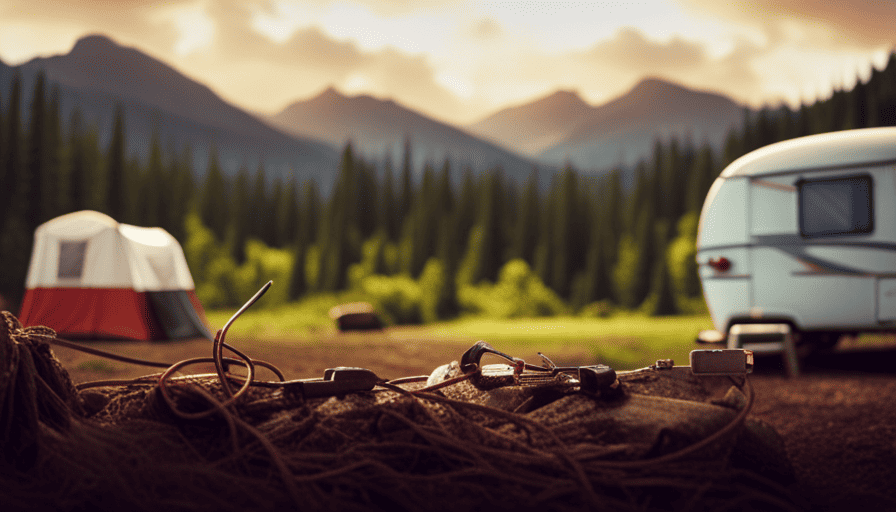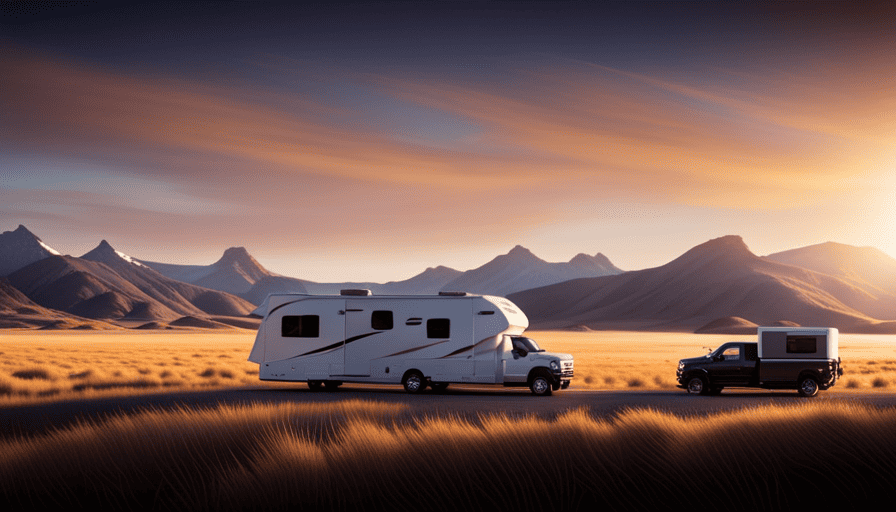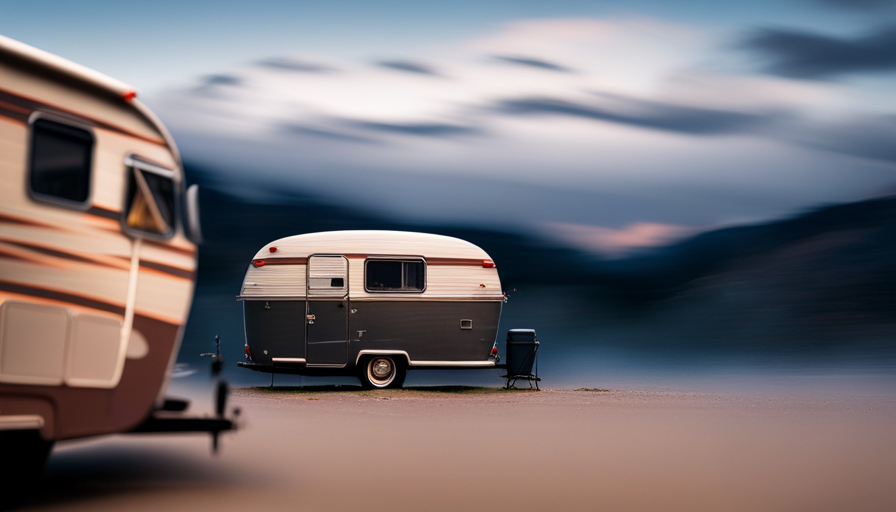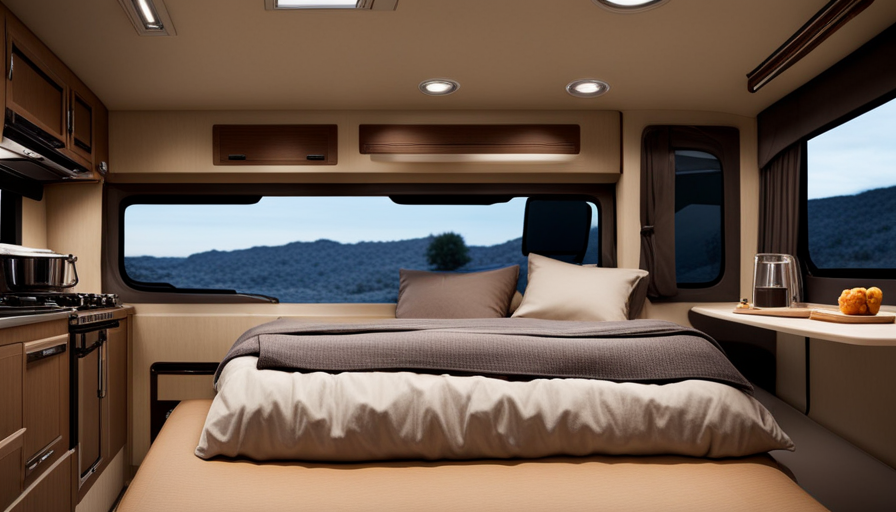Did you know that 80% of RV users experience electrical issues when they connect their vehicles?
It can be frustrating and inconvenient to arrive at your campsite, only to find that your camper is not getting power when plugged in. But fear not, because I’m here to help you troubleshoot and fix this problem.
In this article, I will guide you through a step-by-step process to identify and resolve the issue. We will start by checking the power source and testing the electrical system. Then, we’ll inspect the breakers and fuses, as well as examine the RV’s electrical components.
If needed, we’ll troubleshoot the converter and verify the inverter’s operation. And if all else fails, I’ll provide advice on seeking professional help and considering portable power options.
So let’s dive in and get your camper back up and running!
Key Takeaways
- 80% of campers experience power issues when plugging in their RVs
- Troubleshooting and fixing power issues in campers is crucial.
- Checking power source, testing electrical systems, and verifying power outlet or generator functionality is essential.
- Portable generators and solar power are recommended as backup power sources for campers.
Check the Power Source
Before we dive into troubleshooting the power issue with your camper, let’s first check the power source to ensure it’s not the culprit.
When it comes to powering your camper, portable power solutions are essential for a seamless camping experience. However, occasionally, power issues can arise, leaving you without the necessary electrical supply.
To troubleshoot power issues, start by checking your power source. Ensure that the power outlet or generator you’re using is functioning properly. Check for any loose connections or damaged cords that may be hindering the flow of electricity. Additionally, verify that the power source is capable of providing enough wattage to meet the demands of your camper’s electrical system.
By carefully examining the power source, you can rule out any potential problems in this area.
Once you’ve confirmed the power source isn’t the culprit, it’s time to test the electrical system in your camper. Keep reading to learn how to do this and identify the root cause of the power issue.
Test the Electrical System
First, let’s check if everything’s working properly in your electrical system. To troubleshoot the issue of your camper not getting power when plugged in, there are a few common electrical issues you can investigate. Here are some troubleshooting steps to follow: First, check if the power cord is securely plugged into the camper’s electrical hookup and the power source. Inspect the cord for any damage or fraying that may be causing a poor connection. Next, test the power source with a voltage meter to ensure it’s supplying the proper amount of electricity to the camper. These are essential steps in troubleshooting power issues in camper.
-
Begin by inspecting the power cord and make sure it’s securely connected to both the camper and the power source.
-
Check the circuit breaker panel in your camper and make sure all the breakers are in the ‘on’ position.
-
Test the voltage of the power source using a multimeter to verify it’s delivering the correct amount of electricity.
-
Examine the power inlet on your camper for any signs of damage or loose connections.
-
Inspect the power converter or inverter if your camper has one, as malfunctions in these components can cause power issues.
By going through these troubleshooting steps, you can identify and address common electrical issues that may be preventing your camper from receiving power. Now, let’s move on to the next section and inspect the breakers and fuses to further diagnose the problem.
Inspect the Breakers and Fuses
To address the issue, you should now inspect the breakers and fuses in your electrical system to ensure they are functioning properly, preventing any potential power disruptions. Imagine the intricate web of electrical pathways that these tiny components control, ensuring a smooth flow of electricity throughout your camper.
| Breakers | Fuses |
|---|---|
| Inspect the wiring connected to the breakers | Check the power cord for any damage |
| Ensure the breakers are securely fastened to their respective panels | Verify that the fuses are not blown or burnt out |
| Look for any signs of overheating or corrosion on the breakers | Replace any faulty fuses with ones of the correct amperage |
Inspecting the wiring connected to the breakers is crucial to identify any loose connections or frayed wires that could be causing the power issue. Additionally, checking the power cord for any damage, such as cuts or exposed wires, is essential to ensure a safe and reliable power supply.
Make sure that the breakers are securely fastened to their respective panels to guarantee proper functioning. Look for any signs of overheating or corrosion on the breakers, as these can indicate a potential problem that needs to be addressed.
Verify that the fuses are not blown or burnt out. If you find any faulty fuses, replace them with ones of the correct amperage to restore power to your camper.
Now that we have inspected the breakers and fuses, let’s move on to examining the RV’s electrical components.
Examine the RV’s Electrical Components
Now, let’s take a closer look at the RV’s electrical components and discover the fascinating world of power distribution within your vehicle. When it comes to powering your camper, understanding the various electrical components is crucial.
One of the most important aspects to consider is portable power solutions. These solutions provide the ability to generate power when you’re not connected to an external power source. They typically consist of a battery, inverter, and charger. However, if you’re experiencing issues with power when plugged in, it’s essential to examine these components closely.
Start by checking the battery for any signs of damage or corrosion. Next, inspect the inverter and charger for any loose connections or faulty wiring. These common electrical issues can often be easily resolved by tightening connections or replacing damaged components.
By examining the RV’s electrical components thoroughly, you can ensure that power is being distributed effectively throughout your vehicle.
Now, let’s transition into the next section and troubleshoot the converter to further address any power-related problems.
Troubleshoot the Converter
When troubleshooting the converter, you’ll want to ensure that all connections are securely in place and that there are no signs of overheating or burnt components. Start by examining the converter for any loose or corroded wires. Check the fuse box and circuit breakers to see if any fuses have blown or if any breakers have tripped. Replace any blown fuses and reset any tripped breakers.
Inspect the converter for any signs of overheating, such as discoloration or a burning smell. If you notice any burnt components, they’ll need to be replaced.
Common issues with converters include a faulty converter, low voltage output, or a blown fuse. To check if the converter is functioning properly, use a multimeter to measure the voltage output. It should be around 12 to 14 volts. If the voltage is significantly lower or higher, the converter may need to be replaced.
To test the battery, disconnect it from the converter and use a battery tester to check its voltage. If the voltage is below 12 volts, the battery may need to be charged or replaced.
Transitioning into the next section, testing the battery will help determine if the issue lies with the converter or the battery itself.
Test the Battery
First, check the battery’s voltage using a tester to determine if it needs to be charged or replaced. Here are three steps to assist with battery maintenance and potential replacement:
-
Connect the tester: Attach the positive (red) lead of the tester to the battery’s positive terminal and the negative (black) lead to the negative terminal. Ensure the connections are secure and free of corrosion.
-
Check the voltage: Turn on the tester and read the voltage displayed. A fully charged battery typically measures around 12.6 volts. If the voltage is significantly lower, it may indicate a need for charging or battery replacement.
-
Charge or replace: If the voltage is low, attempt to charge the battery using an appropriate charger. Follow the manufacturer’s instructions and ensure a safe charging environment. If the battery fails to hold a charge or if the voltage remains low after charging, it may need to be replaced.
To verify the inverter’s operation, it’s important to ensure the battery is in optimal condition.
Verify the Inverter’s Operation
To make sure my camper’s inverter is functioning properly, I need to test it and confirm that it’s converting DC power from the battery to AC power. I’ll check the inverter’s settings and connections for any potential issues that could be causing a lack of power. It’s important to be thorough and precise in this process to pinpoint any problems and ensure the inverter is operating correctly.
Test the inverter to ensure it is converting DC power from the battery to AC power for your camper
Before you can bask in the glorious glow of your camper’s electricity, you absolutely must make sure that the inverter is magically transforming your battery’s dull DC power into a mind-blowing AC power extravaganza. To verify the inverter’s operation, it is essential to test its power conversion efficiency and troubleshoot any issues that may arise. A handy way to assess the inverter’s performance is by using a multimeter to measure the DC input voltage and the AC output voltage. By comparing these values and referring to the inverter’s specifications, you can determine if the power conversion is occurring effectively. Additionally, inspect the inverter for any signs of damage or loose connections that may impede its functionality. Once you have thoroughly examined the inverter, you can proceed to the next section to check its settings and connections for any issues.
Table: Inverter Troubleshooting
| Issue | Possible Causes |
|---|---|
| No power output | Faulty inverter, blown fuse, loose connections |
| Low power output | Inefficient power conversion, insufficient input voltage |
| Overheating | Overloaded inverter, inadequate ventilation |
| Strange noises | Loose components, internal damage |
| Erratic power output | Faulty inverter, fluctuating input voltage |
Now, let’s move on to checking the inverter’s settings and connections for any issues.
Check the inverter’s settings and connections for any issues
Now, let’s dive into the inverter’s settings and connections to make sure everything’s in perfect working order and get electrified with excitement!
-
First, check the inverter’s display panel for any error codes or warnings. This can indicate any issues with the inverter’s internal circuitry or settings.
-
Next, inspect the connections between the inverter and the battery. Ensure that the cables are securely connected and free from any damage or corrosion.
-
Pay close attention to the fuse connections, as a blown fuse can disrupt the power supply.
-
Also, check the grounding connection to ensure it’s properly connected to a solid metal surface.
By troubleshooting the inverter and addressing any power supply issues, we can ensure that the camper receives the necessary power when plugged in.
However, if these steps don’t resolve the problem, it may be best to seek professional help to diagnose and fix the issue.
Seek Professional Help
Seeking professional help is a great way to ensure your camper gets the power it needs when plugged in. When it comes to troubleshooting issues related to power supply, professionals have the expertise and experience to identify the problem accurately and provide effective solutions.
They will be able to assess the inverter’s settings and connections thoroughly, ensuring that everything is properly configured and functioning correctly. Additionally, they can perform advanced diagnostics to identify any underlying issues that may not be immediately apparent.
Professional technicians are equipped with the necessary tools and knowledge to handle a wide range of camper power problems. They can quickly identify faults in the wiring, check for any loose connections, and ensure that the inverter is receiving the correct voltage. They can also test the inverter’s output to determine if it is providing the required power to the camper. Moreover, if the inverter needs to be repaired or replaced, they can guide you in choosing the best portable power solutions available in the market.
By seeking professional help, you can save valuable time and avoid potential damage to your camper’s electrical system. Once the power issue is resolved, you can move on to considering portable power options to enhance the overall functionality of your camper.
Consider Portable Power Options
I highly recommend investing in a portable generator as a backup power source for your camper. This will ensure that you always have a reliable source of electricity, even if you’re unable to plug into a power outlet.
Additionally, exploring solar power options is a great way to provide electricity off the grid. Solar panels can be easily installed on the roof of your camper and will harness the power of the sun to keep your appliances running smoothly.
Invest in a portable generator as a backup power source for your camper
Consider investing in a portable generator as a backup power source for your camper, so you won’t be left in the dark when plugged in. Here are four reasons why a portable generator is a great alternative power option for campers:
-
Portability: Portable generators are designed to be easily carried and transported, making them convenient for camping trips.
-
Versatility: With a portable generator, you can power multiple devices simultaneously, such as your refrigerator, air conditioning unit, and lighting system.
-
Reliable Power: Portable generators offer a steady and reliable power supply, ensuring that your camper’s electrical needs are met consistently.
-
Emergency Preparedness: Having a portable generator as a backup power source provides peace of mind during unexpected power outages or emergencies.
Investing in a portable generator offers numerous benefits when it comes to providing power for your camper. However, if you’re looking for a more sustainable and off-grid option, explore solar power options to provide electricity off the grid.
Explore solar power options to provide electricity off the grid
To harness the sun’s energy and go off the grid, you can explore solar power options for your camper, giving you the freedom to power your devices without relying on traditional electricity sources. One option is to install solar panels on the roof of your camper. These panels are made up of photovoltaic cells that convert sunlight into electricity. By capturing the sun’s rays, solar panels can provide a sustainable and renewable source of power for your camper. There are several benefits to using solar power. Firstly, it is environmentally friendly, as it produces no greenhouse gas emissions. Secondly, it can save you money in the long run by reducing your reliance on grid electricity. Lastly, solar power allows you to have electricity even when you are camping in remote locations. Transitioning into the subsequent section, it is important to take preventative measures to ensure your camper is protected from power outages.
Take Preventative Measures
Make sure you take preventative measures to ensure your camper gets the power it needs when plugged in. When considering portable power options and solar power alternatives, it’s essential to implement measures that will optimize your camper’s power supply.
One key preventive measure is to conduct a thorough inspection of your camper’s electrical system. Check for any loose or damaged connections, as these can cause power loss. Additionally, make sure all electrical components are securely fastened and properly insulated to prevent any potential power disruptions.
Another crucial step is to install surge protectors in your camper’s electrical system. These devices will safeguard your camper’s electrical appliances from power surges, which can cause irreparable damage. By installing surge protectors, you can effectively protect your camper’s power supply and extend the lifespan of your electrical equipment.
Furthermore, it’s imperative to regularly clean and maintain your solar panels and batteries. Dust, dirt, and debris can reduce the efficiency of your solar panels, resulting in decreased power generation. Clean the panels regularly and inspect them for any signs of damage. Also, make sure your camper’s batteries are properly charged and functioning optimally, as weak or faulty batteries can hinder power supply.
By taking these preventative measures, you can ensure that your camper receives the power it needs when plugged in. Implementing these measures will not only optimize your camper’s power supply but also enhance the overall efficiency and longevity of your electrical system.
Frequently Asked Questions
How can I determine if the power source I am plugged into is functioning properly?
To determine the reliability of a power source, I use a systematic approach to troubleshoot the camper power converter.
First, I check if there’s any power output from the source by using a voltage meter.
Next, I inspect the power cord for any visible damage or loose connections.
If everything appears to be in order, I test the power source with another device to confirm if it’s functioning properly.
This process ensures a thorough assessment of the power source’s reliability.
What steps should I take to troubleshoot the converter in my camper if I am not getting power?
To troubleshoot the converter in your camper, there are several troubleshooting techniques you can use.
Start by checking the power source and ensuring it’s delivering the correct voltage.
Inspect the converter for any visible damage or loose connections.
Test the fuses and circuit breakers to ensure they aren’t tripped or blown.
Additionally, common camper power issues include faulty wiring, defective appliances, or a malfunctioning converter.
Can I use a portable power option as a temporary solution if I am not getting power when plugged into a campground’s electrical system?
Yes, as a temporary solution, you can use a portable generator or solar panels to power your camper if you’re not getting power from a campground’s electrical system.
A portable generator can provide the necessary electricity to run your appliances and charge your batteries. Similarly, solar panels can harness the sun’s energy and convert it into usable power.
Both options offer flexibility and independence, ensuring that you have a reliable source of power for your camper.
What are some preventative measures I can take to avoid experiencing power issues in my camper?
To ensure uninterrupted power supply in my camper, I prioritize preventative maintenance. Regularly inspecting and cleaning electrical connections, outlets, and circuit breakers is crucial. Installing power surge protection devices safeguards the camper’s electrical system from sudden voltage spikes.
Additionally, using high-quality extension cords and adapters designed for outdoor use helps maintain a stable power connection. These measures minimize the risk of power issues and ensure a smooth camping experience.
When should I consider seeking professional help for my camper’s power issues instead of attempting to fix it myself?
When it comes to power issues with my camper, I always weigh the decision of DIY versus seeking professional assistance. Knowing when to seek professional help is crucial.
If I have exhausted all my troubleshooting efforts and still can’t resolve the power problem, or if I lack the necessary technical expertise, it’s time to call in a professional. They have the specialized knowledge and equipment to diagnose and fix complex electrical issues, ensuring my camper’s power system is safe and reliable.
Conclusion
As I wrap up my troubleshooting journey, I’m reminded of the intricate dance between power and adventure.
Just like a camper relies on a steady source of electricity to fuel their journeys, our lives too depend on a steady flow of energy.
By meticulously checking the power source, testing the electrical system, and examining every component, we’ve successfully unraveled the mystery behind a powerless camper.
Remember, in the realm of power, knowledge is key. And with that, we’re unstoppable in our quest for endless exploration.










